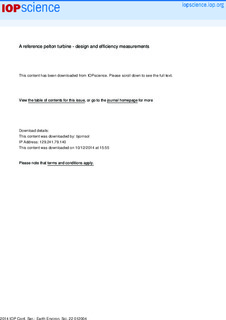| dc.contributor.author | Solemslie, Bjørn Winther | |
| dc.contributor.author | Dahlhaug, Ole Gunnar | |
| dc.date.accessioned | 2014-12-10T15:55:22Z | |
| dc.date.accessioned | 2016-06-15T08:40:58Z | |
| dc.date.available | 2014-12-10T15:55:22Z | |
| dc.date.available | 2016-06-15T08:40:58Z | |
| dc.date.issued | 2014 | |
| dc.identifier.citation | IOP Conference Series: Earth and Environment 2014, 22(1) | nb_NO |
| dc.identifier.issn | 1755-1307 | |
| dc.identifier.uri | http://hdl.handle.net/11250/2392623 | |
| dc.description.abstract | The Pelton turbine has been subject to a varying degree of research interest since the debut of the technology over a century ago. Despite its age there are gaps in the knowledge concerning the flow mechanisms effecting the flow through the turbine. A Pelton turbine has been designed at the Waterpower Laboratory at NTNU. This has been done in connection to a Ph.D. project focusing on the flow in Pelton turbine buckets. The design of the turbine has been conducted using in-house knowledge in addition to some comments from a turbine producer. To describe the geometry multiple Bezier curves were used and the design strategy aimed to give a smooth and continuous gradient along the main flow directions in the bucket. The turbine has been designed for the operational conditions of the Pelton test rig installed at the Waterpower Laboratory which is a horizontal single jet test rig with a jet diameter(ds) of 35 mm. The diameter(D) of the runner was set to 513 mm and the width(W) of a bucket 114 mm, leading to a D/W ratio of 4.5. Manufacturing of the turbine has been carried out in aluminium and the turbine has undergone efficiency testing and visual inspection during operation at a head of 70 m. The turbine did not performed as expected and the maximum efficiency was found to be 77.75%. The low efficiency is mainly caused by a large amount of water leaving the bucket through the lip and hence transferring close to zero of its energy to the shaft. The reason for the large lip loss is discussed and two possible causes are found; the jet is located too close to the lip, and the inner surface of the bucket does not lead the water away from the lip. The turbine geometry and all data from both measurements and simulations will be available upon request in an effort to increase the amount of available data concerning Pelton turbines. | nb_NO |
| dc.language.iso | eng | nb_NO |
| dc.publisher | IOP Publishing | nb_NO |
| dc.relation.uri | http://iopscience.iop.org/1755-1315/22/1/012004/pdf/1755-1315_22_1_012004.pdf | |
| dc.rights | Navngivelse 3.0 Norge | * |
| dc.rights.uri | http://creativecommons.org/licenses/by/3.0/no/ | * |
| dc.title | A reference pelton turbine - design and efficiency measurements | nb_NO |
| dc.type | Journal article | nb_NO |
| dc.type | Peer reviewed | nb_NO |
| dc.date.updated | 2014-12-10T15:55:28Z | |
| dc.subject.nsi | VDP::Teknologi: 500::Maskinfag: 570::Mekaniske og strømningstekniske fag: 574 | nb_NO |
| dc.subject.nsi | VDP::Technology: 500::Mechanical engineering: 570::Mechanical and flow technical subjects: 574 | nb_NO |
| dc.source.volume | 22 | nb_NO |
| dc.source.journal | IOP Conference Series: Earth and Environment | nb_NO |
| dc.source.issue | 1 | nb_NO |
| dc.identifier.doi | 10.1088/1755-1315/22/1/012004 | |
| dc.identifier.cristin | 1183684 | |
| dc.subject.keyword | Strømningsteknikk / Engineering fluid mechanics | |
| dc.subject.keyword | Turbin / Turbine | |
| dc.subject.keyword | Vannkraft / Hydropower | |
| dc.description.localcode | Content from this work may be used under the terms of the Creative Commons Attribution 3.0 licence. Any further distribution of this work must maintain attribution to the author(s) and the title of the work, journal citation and DOI. | nb_NO |

